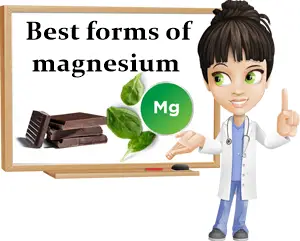There are many benefits to taking magnesium supplements, not just correcting a deficiency of the mineral.
From treating muscle spasms and cramps, including painful calf or foot cramps that occur after exercise or during nighttime and restless leg syndrome, insomnia, migraines, high blood pressure to reducing anxiety and stress, there are many uses for magnesium supplements. Fortunately, side effects are rare, mild and reversible and only occur with excessively high doses of the mineral, making supplementation a sure and safe way to correct a deficiency of the mineral and associated side effects.
But not all magnesium supplements are the same.
Different formulations of the mineral are available and all have different absorption rates. And because not all magnesium forms are absorbed equally, choosing one formulation over another can really make a difference when it comes to the health benefits one enjoys as a result of supplementation with said formulation.
So which is the best absorbed magnesium form and why is it the best?

Which is the best absorbed magnesium form?
If you are wondering what is the best magnesium to take, know that opinions are divided regarding which form is really the best, if there is even one, or just one.
If you are looking to correct a deficiency and enjoy some of the wonderful benefits the mineral has to offer, know there isn’t just one type of magnesium supplement you can take.
Most formulations of the mineral will help correct a deficiency and provide important benefits with sometimes almost immediate results.
The more severe the magnesium deficiency, the more likely it is any formulation will work great, even those poorly rated in terms of absorption such as magnesium oxide. A deficient organism will accept any help it can get, in any form, and make the best of it. Especially considering the fact that nutritional deficiencies in general tend to encourage higher than normal uptakes.
Organic vs inorganic magnesium forms ( What are The Differences ?)
Magnesium formulations are often classified as organic versus inorganic, with the latter being less bioavailable, or not so well absorbed.
One of the worst forms of magnesium to take, some say the worst, is magnesium oxide, which also happens to be classified as an inorganic form of the mineral.
Magnesium sulfate is also an inorganic formula, but with a better absorption rate compared to magnesium oxide, yet still low.
Magnesium chloride is another type of inorganic form, hence its poor rating in terms of bioavailability, although better than both sulfate and oxide formulations.
Lastly, magnesium carbonate is an inorganic magnesium form with up to 10%, sometimes 20% absorption values which makes its widespread presence in dietary supplements justifiable.
Whereas some of the best absorbed magnesium forms are organic ones and include formulations such as magnesium aspartate, gluconate, lactate or citrate.
For these formulations, absorption rates vary from 30% (for the magnesium citrate formulation) to 67% (for the magnesium gluconate formulation). Overall, of the two different types of magnesium supplements to take, the best are organic.

Chelated vs non-chelated magnesium forms
What is chelated magnesium?
Some compounds such as amino acids (aspartic acid, glycine) or organic acids (malic acid naturally found in rhubarb and apples, citric acid naturally found in citrus fruit) have an affinity to metals and tend to bind to them. These compounds are called ‘chelators’ and they associate with said metals in a particular arrangement that results in a chelated form of the metal. For example, when a molecule of the amino acid glycine binds to a molecule of magnesium it results in a formulation called chelated magnesium glycinate.
Chelated forms of magnesium are proposed to be more bioavailable than non-chelated formulations because they have a higher absorption rate.
Because an amino acid or organic acid is a natural compound, the body absorbs it rapidly and effectively, so magnesium bound to such a compound will enjoy the same bioavailability.
Chelated magnesium forms are proposed to hold more benefits, or more specific benefits, than non-chelated forms.
While it’s true they are more bioavailable and, as a result, stand to produce more benefits, they do share the same health effects as any other form of the mineral.
So saying you take chelated magnesium glycinate for migraines and better sleep, aspartate for tinnitus and high blood pressure, citrate for constipation or chelated magnesium for asthma, laryngospasms or chronic fatigue is not scientifically accurate.
You are, in fact, taking different formulations of the same mineral for their different rates of absorption, essentially looking for what is better absorbed (and also for a formulation that has fewer side effects).
The different forms of magnesium offer the exact same benefits, but some are preferred over others for how well the body absorbs them. So the only difference is some formulations are better absorbed, others not so much, but since you need more magnesium to treat some conditions and their symptoms and less to treat others, it stands to reason you will go for the best absorbed forms.
Amino acid-bound vs acid-bound magnesium forms
What makes magnesium supplements different from one another is their formulation, more specifically, the type of compound the mineral magnesium is bound to. Some of the best formulations are organic magnesium supplements. In these formulations, the mineral is bound to organic compounds, usually either amino acids or organic acids.
Amino acids such as glycine, aspartic acid and organic acids such as malic acid, citric acid, gluconic acid or lactic acid help produce some of the best forms of magnesium: Mg glycinate, Mg aspartate, Mg malate, Mg citrate, Mg gluconate and Mg lactate. The highest absorption rate belongs to Mg gluconate, closely followed by Mg aspartate, then Mg lactate, so both amino acid and organic acid-bound forms have overall high bioavailability.
What is the best overall form of magnesium?
The best type of magnesium supplement to take, according to research, is magnesium gluconate.
According to the European Food Safety Authority, it has an absorption rate of 67% and a retention value of 49%.
The second best form is magnesium aspartate with an absorption rate of 60% and a retention value of 47%. The third best form is magnesium lactate with an absorption rate of 59% and a retention value of 49%.
Next are other organic forms such as those where the mineral is bound to amino acids or various acids: magnesium (Mg) pidolate, magnesium (Mg) orotate, magnesium (Mg) glycinate, magnesium (Mg) citrate etc.
And, lastly, inorganic forms such as: magnesium (Mg) carbonate, magnesium (Mg) chloride, magnesium (Mg) sulfate, and magnesium (Mg) oxide.
Conclusion
Even if you are taking the absolute best magnesium form, it is important to make sure your diet provides some of the best food sources of the mineral to help with correcting a potential deficiency.
Spinach, Swiss chard and its variant, rainbow chard, beet greens and all green, leafy vegetables are great sources of magnesium and take the top of the list.
Plants absorb magnesium from the soil and use the mineral to make chlorophyll, so the darker green the leaves, the better in terms of magnesium content.
Seasoning herbs such as parsley, lovage, basil, dill, coriander or cilantro and chives are also included in the list of best magnesium foods, although they are meant to be consumed in more limited amounts than culinary vegetables and thus provide limited amounts of magnesium.
Next up are nuts and seeds, notably pumpkin, sesame seeds and watermelon seeds, almonds, cashews, peanuts, walnuts, Brazil nuts and the flours made from them.
High-protein beans, lentils, chickpeas and soybeans, cereal grains, bananas, avocado and milk are also some of the best magnesium foods you can eat.
A balanced diet supplying a variety of foods rich in the mineral together with one of the best absorbed magnesium supplement forms of your choice can set the tone for excellent nutrition and reverse a deficiency and its side effects.
